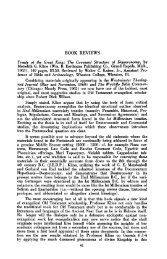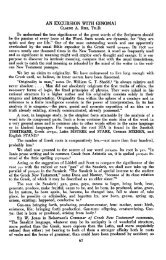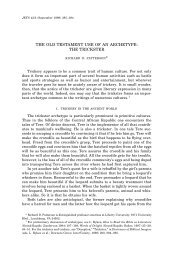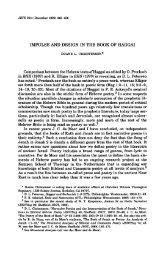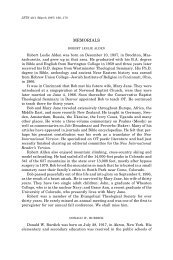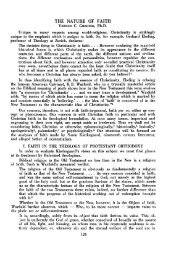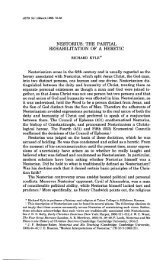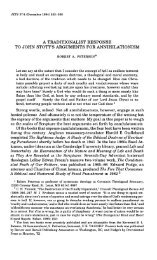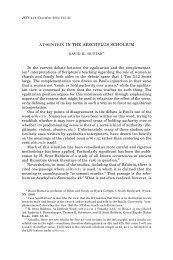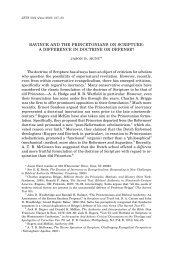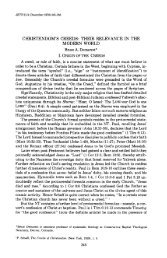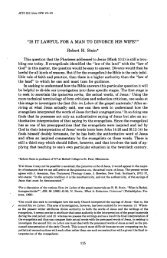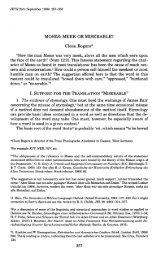current hermeneutical trends: toward explanation or obfuscation?
current hermeneutical trends: toward explanation or obfuscation?
current hermeneutical trends: toward explanation or obfuscation?
Create successful ePaper yourself
Turn your PDF publications into a flip-book with our unique Google optimized e-Paper software.
JETS 39/2 (June 1996) 241–256<br />
CURRENT HERMENEUTICAL TRENDS:<br />
TOWARD EXPLANATION OR OBFUSCATION?<br />
ROBERT L. THOMAS*<br />
The following remarks come from an exegetical practitioner, one who does<br />
not consider himself a <strong>hermeneutical</strong> the<strong>or</strong>etician and has no aspirations<br />
<strong>toward</strong> becoming one. As a practicing exegete, I know the painstaking di¯culty<br />
of writing a commentary but have only dabbled in the the<strong>or</strong>etical aspects<br />
of hermeneutics. Yet I feel a compulsion to interact with recent w<strong>or</strong>ks<br />
on hermeneutics whose purpose is to furnish the rules to guide my practice<br />
of exegesis. In other w<strong>or</strong>ds, the discussion herein stems from observing the<br />
possible eˆects of recent the<strong>or</strong>ies on the practice of Biblical interpretation.<br />
Writing a w<strong>or</strong>k such as those that have appeared recently is a yeoman’s<br />
task. I must express admiration f<strong>or</strong> the diligence of my fellow evangelicals<br />
who have recently published <strong>hermeneutical</strong> volumes and my appreciation<br />
f<strong>or</strong> the bene˜cial material they have provided us. Indeed they have amassed<br />
a tremendous amount of data f<strong>or</strong> our use.<br />
Their contributions, however, appear to be having a secondary eˆect of<br />
polarizing evangelicals into two camps. Some recent <strong>hermeneutical</strong> <strong>trends</strong><br />
have f<strong>or</strong>ced evangelical interpreters to choose between two <strong>hermeneutical</strong><br />
wavelengths that oppose each other in rather dramatic ways. The diˆerence<br />
between the two is comparable to an athletic encounter in which one team<br />
abides by the rules of Australian football and the other by those of American<br />
football. The two teams do not belong on the same playing ˜eld because<br />
they have no common guidelines to regulate their encounter.<br />
M. Silva hints at the cleavage I am referring to when he observes that<br />
the vast maj<strong>or</strong>ity of books and articles dealing with the biblical text continue<br />
to place pri<strong>or</strong>ity on its hist<strong>or</strong>ical meaning. Especially puzzling is the fact that,<br />
from time to time, one may hear a scholar at a professional meeting who seems<br />
to adopt the newer approach at least the<strong>or</strong>etically but whose actual interpretive<br />
w<strong>or</strong>k does not appear substantially diˆerent from standard hist<strong>or</strong>ical exegesis.<br />
In other w<strong>or</strong>ds, the abandonment of auth<strong>or</strong>ial and hist<strong>or</strong>ical interpretation<br />
would be di¯cult to document from the usual articles published in the recognized<br />
journals of biblical scholarship. 1<br />
In essence, Silva says that the challenges to the traditional method of interpretation<br />
are thus far only the<strong>or</strong>etical and that the practical approach of<br />
evangelicals to interpretation is the same as it has always been.<br />
* Robert Thomas is profess<strong>or</strong> of New Testament at The Master’s Seminary, 13248 Roscoe Blvd.,<br />
Sun Valley, CA 91352.<br />
1Ù M. Silva, An Introduction to Biblical Hermeneutics: The Search f<strong>or</strong> Meaning (coauth<strong>or</strong>ed with<br />
W. C. Kaiser, Jr.; Grand Rapids: Zondervan, 1994) 234–235.
242<br />
JOURNAL OF THE EVANGELICAL THEOLOGICAL SOCIETY<br />
In referring to “the abandonment of auth<strong>or</strong>ial and hist<strong>or</strong>ical interpretation,”<br />
Silva speaks of a departure from the grammatical-hist<strong>or</strong>ical approach<br />
to interpretation. 2 Such a change in methodology is surprising, coming as it<br />
does so closely on the heels of consensus statements by evangelicals in the<br />
late 1970s and early 1980s that the grammatical-hist<strong>or</strong>ical method is the<br />
only one compatible with a view that the Bible is without err<strong>or</strong>. 3<br />
It was not unusual to encounter missiological and feminist challenges to<br />
the grammatical-hist<strong>or</strong>ical method during the early 1980s, 4 sometimes coming<br />
from outside and sometimes from within the inerrantist camp. 5 The difference<br />
in the 1990s is that evangelical scholars who are theological and<br />
Biblical specialists and are solidly within the inerrantist camp are raising<br />
questions about the validity of the traditional method. 6 This new movement<br />
<strong>toward</strong> change has created confusion f<strong>or</strong> a number of reasons, a few of which<br />
the following survey will propose.<br />
I. NEW AND CONFLICTING DEFINITIONS<br />
One of the reasons has been an assignment of new and sometimes<br />
con˘icting de˜nitions f<strong>or</strong> terms whose meanings have been reasonably clear<br />
until this new barrage of <strong>hermeneutical</strong> literature began. The following<br />
2Ù Ibid. 19; cf. Kaiser, pp. 31, 33. The grammatical-hist<strong>or</strong>ical method, the traditional method, is<br />
not equivalent to the hist<strong>or</strong>ical-critical method as some have erroneously assumed (e.g. K. Haleblian,<br />
“The Problem of Contextualization,” Missiology: An International Review 9/1 [January 1983]<br />
103; A. Johnson, “The Hist<strong>or</strong>ical-Critical Method: Egyptian Gold <strong>or</strong> Pagan Precipice?”, JETS<br />
26/1 [1983] 3–15; Silva, Biblical Hermeneutics 19 n. 2; L. W. Caldwell, “Third H<strong>or</strong>izon Ethnohermeneutics:<br />
Re-evaluating New Testament Hermeneutical Models f<strong>or</strong> Intercultural Bible Interpreters<br />
Today” [paper presented to Consultation of Anthropologists and Theologians, Biola University,<br />
April 14–15, 1986] 2). Kaiser points out distinctions between the two methods (Biblical Hermeneutics<br />
32, 235–236). The distinction lies in the connotation of the term “critical,” which often connotes<br />
a skeptical approach to the Scriptures (D. J. Harrington, “Biblical Hermeneutics in Recent<br />
Discussion: New Testament,” RelSRev 10/1 [1984] 8). Hence hist<strong>or</strong>ical criticism had to discount<br />
inspiration as a fact<strong>or</strong> in Biblical exegesis (K. Froehlich, “Biblical Hermeneutics on the Move,”<br />
WW 1/2 [1981] 141).<br />
3Ù Article XVIII, “Articles of A¯rmation and Denial, The Chicago Statement on Biblical Inerrancy,”<br />
International Council on Biblical Inerrancy (Chicago, 1978); Article XV, “Articles of A¯rmation<br />
and Denial, The Chicago Statement on Biblical Hermeneutics,” International Council on<br />
Biblical Inerrancy (Chicago, 1982).<br />
4Ù C. H. Kraft, Christianity in Culture (Maryknoll: Orbis, 1979) 123, 129–132, 136–137; S. G.<br />
Lingenfelter, “F<strong>or</strong>mal Logic <strong>or</strong> Practical Logic: Which Should F<strong>or</strong>m the Basis f<strong>or</strong> Cross-Cultural<br />
Theology?” (paper presented at the Consultation of Anthropologists and Theologians, Biola University,<br />
April 14–15, 1986) 21; L. M. Russell, “Introduction: Liberating the W<strong>or</strong>d,” Feminist Interpretation<br />
of the Bible (ed. Russell; Philadelphia: Westminster, 1985) 11, 16; K. D. Sakenfeld,<br />
“Feminist Uses of Biblical Materials,” Feminist Interpretation (ed. Russell) 55–56; E. S. Fi<strong>or</strong>enza,<br />
“Toward a Feminist Biblical Hermeneutics: Biblical Theology and Liberation Theology,” The<br />
Challenge of Liberation Theology: A First W<strong>or</strong>ld Response (Maryknoll: Orbis, 1981) 93–94.<br />
5Ù W. S. LaS<strong>or</strong>, “The Sensus Pleni<strong>or</strong> and Biblical Interpretation,” Scripture, Tradition, and Interpretation<br />
(ed. W. W. Gasque and W. S. LaS<strong>or</strong>; Grand Rapids: Eerdmans, 1978) 266–268, 270,<br />
271–272, 274–275; P. K. Jewett, Man as Male and Female (Grand Rapids: Eerdmans, 1975) 133–<br />
135.<br />
6Ù D. McCartney and C. Clayton, Let the Reader Understand: A Guide to Interpreting and<br />
Applying the Bible (Wheaton: Vict<strong>or</strong>, 1994) 68, 82, 150.
CURRENT HERMENEUTICAL TRENDS 243<br />
comparisons ˘ow from de˜nitions of terms given and usages of those terms<br />
in various parts of this body of literature.<br />
1. Hermeneutics. The term “hermeneutics” in one source means “the<br />
practice of biblical interpretation,” 7 but in another it denotes “seeking the<br />
contemp<strong>or</strong>ary relevance of ancient texts.” 8 A few pages later, the same source<br />
that calls hermeneutics “the practice of biblical interpretation” de˜nes it as<br />
“the principles people use to understand what something means” 9 and the<br />
conceptual framew<strong>or</strong>k f<strong>or</strong> interpreting c<strong>or</strong>rectly by means of accurate exegesis.<br />
10 Yet elsewhere the same w<strong>or</strong>k speaks of the goal of hermeneutics as an<br />
understanding of the impact of Scripture on ourselves. 11 This book in another<br />
place says the goal of hermeneutics is “to arrive at the meaning of the text that<br />
the biblical writers <strong>or</strong> edit<strong>or</strong>s intended their readers to understand.” 12<br />
Another recent volume says that hermeneutics includes what the text<br />
meant and what it means. 13 The same one says the ˜nal goal of hermeneutics<br />
is the sermon 14 and that the <strong>hermeneutical</strong> spiral extends to include<br />
exegesis, Biblical theology, hist<strong>or</strong>ical theology, systematic theology and practical<br />
theology. 15 In yet another excerpt it identi˜es hermeneutics as the rules<br />
of interpretation. 16<br />
A source in addition to the three already cited furnishes the traditional<br />
de˜nition of hermeneutics: the discipline that deals with principles of interpretation<br />
17 —but later in an apparent deviation from that de˜nition notes<br />
that the <strong>hermeneutical</strong> task includes exegetical and theological components. 18<br />
It proceeds even further a˜eld when speaking of “hermeneutic” (note the<br />
singular) as the meaning of Scripture f<strong>or</strong> our day 19 and of application as an<br />
integral part of the <strong>hermeneutical</strong> task. 20 A yet-uncited source agrees that<br />
application is part of hermeneutics 21 but elsewhere refers to “<strong>hermeneutical</strong><br />
congruence” as an interaction of general and special revelation. 22<br />
7Ù W. W. Klein, C. L. Blomberg and R. L. Hubbard, Jr., Introduction to Biblical Interpretation<br />
(Dallas: W<strong>or</strong>d, 1993) xix.<br />
8Ù G. D. Fee and D. Stuart, How to Read the Bible f<strong>or</strong> All Its W<strong>or</strong>th (2d ed.; Grand Rapids:<br />
Zondervan, 1993) 25; cf. E. A. Nida and W. D. Reyburn, Meaning Across Culture (Maryknoll:<br />
Orbis, 1981) 30.<br />
9Ù Klein et al., Biblical Interpretation 4.<br />
10Ù Ibid. 19.<br />
11Ù Ibid. 18.<br />
12Ù Ibid. 97 (italics theirs).<br />
13Ù G. R. Osb<strong>or</strong>ne, The Hermeneutical Spiral: A Comprehensive Introduction to Biblical Interpretation<br />
(Downers Grove: InterVarsity, 1991) 5.<br />
14Ù Ibid. 12, 343.<br />
15Ù Ibid. 265.<br />
16Ù Ibid. 353.<br />
17Ù Silva, Biblical Hermeneutics 15.<br />
18Ù Kaiser, Biblical Hermeneutics 193.<br />
19Ù Silva, Biblical Hermeneutics 231.<br />
20Ù Kaiser, Biblical Hermeneutics 272.<br />
21Ù McCartney and Clayton, Let the Reader 78.<br />
22Ù Ibid. 60.
244<br />
JOURNAL OF THE EVANGELICAL THEOLOGICAL SOCIETY<br />
A further w<strong>or</strong>k compounds the confusion even m<strong>or</strong>e by oˆering three<br />
senses f<strong>or</strong> the term “hermeneutics”: (1) the actual techniques of Biblical interpretation,<br />
(2) the application of these techniques—with the results of<br />
that endeav<strong>or</strong> <strong>or</strong> the interpretation of the passage, and (3) the whole conception<br />
of the nature of the interpretational task. 23<br />
One recent volume seemed to advance a straightf<strong>or</strong>ward de˜nition of<br />
hermeneutics. It de˜ned hermeneutics as the science and art of interpreting<br />
the Bible. 24 By “science” the auth<strong>or</strong> refers to the principles followed,<br />
and by “art” he has in mind the proper observation of those rules. 25 Yet by<br />
including such observation under the rubric of “hermeneutics,” the auth<strong>or</strong><br />
violates his own distinction between hermeneutics and exegesis, the latter<br />
of which he equates with the actual interpretation of the Bible. 26<br />
Another w<strong>or</strong>k avoids this pitfall by de˜ning hermeneutics as the science<br />
of textual interpretation of the Bible, but then clouds the picture by allowing<br />
issues of philosophy and linguistics to enter the discussion. 27<br />
2. Exegesis. Another w<strong>or</strong>d that has b<strong>or</strong>ne the brunt of multiple meanings<br />
is “exegesis.” G. Osb<strong>or</strong>ne sees exegesis as a subcateg<strong>or</strong>y of hermeneutics<br />
that is synonymous with a grammatical-hist<strong>or</strong>ical approach to interpretation<br />
and inseparable from practical application. 28 G. Fee and D. Stuart,<br />
in contrast, de˜ne exegesis as “a careful, systematic study of the Scripture<br />
to discover the <strong>or</strong>iginal intended meaning” and see it as quite separate<br />
from hermeneutics, by which they refer to practical application. 29 W. Klein,<br />
C. Blomberg and R. Hubbard (hereafter KBH) take hermeneutics to be a<br />
conceptual framew<strong>or</strong>k utilized f<strong>or</strong> interpreting c<strong>or</strong>rectly by means of accurate<br />
exegesis, but at the same time end<strong>or</strong>se Osb<strong>or</strong>ne’s de˜nition of hermeneutics<br />
as the overall term that includes exegesis and contextualization. 30<br />
The same auth<strong>or</strong>s later note that “eˆective exegesis not only perceives what<br />
the message meant <strong>or</strong>iginally but also determines how best to express that<br />
meaning to one’s contemp<strong>or</strong>aries” and equate this reexpression in the language<br />
of today with contextualization. 31 So at the earlier point they distinguish<br />
contextualization from exegesis, but later they inc<strong>or</strong>p<strong>or</strong>ate it as an<br />
integral part of exegesis.<br />
Without giving a direct de˜nition of exegesis, D. McCartney and C. Clayton<br />
appear to view it as a determination of the human auth<strong>or</strong>’s meaning<br />
plus a divinely intended meaning that stems from a believer’s sensitivity to<br />
God f<strong>or</strong> its results. 32 Acc<strong>or</strong>ding to W. Kaiser and M. Silva, exegesis must<br />
take into account <strong>current</strong> relevancy, application, and contemp<strong>or</strong>ary signi˜-<br />
23Ù M. J. Erickson, Evangelical Interpretation (Grand Rapids: Baker, 1993) 9.<br />
24Ù R. B. Zuck, Basic Bible Interpretation (Wheaton: Vict<strong>or</strong>, 1991) 19.<br />
25Ù Ibid. 20, 61.<br />
26Ù Ibid. 19–20.<br />
27Ù E. E. Johnson, Exposit<strong>or</strong>y Hermeneutics: An Introduction (Grand Rapids: Zondervan, 1990) 8.<br />
28Ù Osb<strong>or</strong>ne, Spiral 5, 170, 318.<br />
29Ù Fee and Stuart, How to Read 19, 25.<br />
30Ù Klein et al., Biblical Interpretation 170, including n. 25; cf. Osb<strong>or</strong>ne, Spiral 5.<br />
31Ù Klein et al., Biblical Interpretation 174.<br />
32Ù McCartney and Clayton, Let the Reader 162.<br />
LONG
CURRENT HERMENEUTICAL TRENDS 245<br />
cance of a Biblical text. 33 Yet Kaiser also notes that use of the analogy of<br />
faith must come after exegesis is complete. 34 Does this mean that one cannot<br />
summarize all that God teaches on a given subject until after he has<br />
applied the relevant texts to <strong>current</strong> situations? Indeed, a cloud of confusion<br />
hovers over what one should understand the term “exegesis” to mean.<br />
3. Meaning. Even the meaning of the term “meaning,” once a stable<br />
way of referring to the auth<strong>or</strong>’s intention, has become a source of uncertainty.<br />
One now must stipulate whether it is meaning as referent (i.e. what<br />
the text is talking about), meaning as sense (i.e. what is being said about the<br />
referent), meaning as intention (i.e. what the truth intention of the auth<strong>or</strong><br />
is), and meaning as signi˜cance (i.e. meaning as contemp<strong>or</strong>ary signi˜cance).<br />
35 To these one could add meaning as value and meaning as entailment.<br />
36 So a multifaceted de˜nition of “meaning” has further beclouded the<br />
challenge of understanding the Bible. Kaiser himself—the source of the discussion<br />
of the multiple meanings of “meaning”—seems to violate his own<br />
distinctions later when he comments that the analogy of faith comes into<br />
play after establishing the meaning of a passage from its immediate context.<br />
37 He does not clarify which of the six meanings of meaning he means<br />
by “meaning” in this statement. Silva in the same volume says that “the<br />
meaning of a text should not be identi˜ed with the auth<strong>or</strong>’s intention in<br />
an exclusive and absolute fashion.” 38<br />
In this text Silva also lists no less than eight levels of meaning that in<br />
large measure do not c<strong>or</strong>respond with the ˜ve (<strong>or</strong> six) meanings of meaning<br />
that his coauth<strong>or</strong> Kaiser lists. 39 McCartney and Clayton join Kaiser and<br />
Silva in arguing f<strong>or</strong> the inseparability of meaning and signi˜cance, thereby<br />
in eˆect agreeing with them by including signi˜cance as a part of meaning. 40<br />
Osb<strong>or</strong>ne on the other hand fav<strong>or</strong>s maintaining a distinction between<br />
meaning and signi˜cance. 41 In line with this de˜nition, he consistently argues<br />
that the meaning of a text refers to the auth<strong>or</strong>’s intended meaning. 42<br />
Yet at other points he creates m<strong>or</strong>e confusion by lapsing into the “what-itmeant-what-it-means”<br />
terminology. 43 He further complicates the picture by<br />
drawing a distinction between “meaning” and “interpretation.” 44<br />
W. R. Tate goes even further in advocating that meaning derives from the<br />
text itself as well as from the auth<strong>or</strong> and the contemp<strong>or</strong>ary reader. 45 Textual<br />
33Ù Kaiser and Silva, Biblical Hermeneutics 10.<br />
34Ù Ibid. 192, 194, 203–204.<br />
35Ù Kaiser, Biblical Hermeneutics 34–44.<br />
36Ù Ibid. 44–45.<br />
37Ù Ibid. 194.<br />
38Ù Silva, Biblical Hermeneutics 245 (italics his).<br />
39Ù Ibid. 20–22.<br />
40Ù McCartney and Clayton, Let the Reader 31, 276, 300 n. 47.<br />
41Ù Osb<strong>or</strong>ne, Spiral 7.<br />
42Ù Ibid. 219.<br />
43Ù Ibid. 268.<br />
44Ù Ibid. 354.<br />
45Ù W. R. Tate, Biblical Interpretation: An Integrated Approach (Peabody: Hendrickson, 1991)<br />
210.
246<br />
JOURNAL OF THE EVANGELICAL THEOLOGICAL SOCIETY<br />
autonomy assumes that the text itself, apart from its hist<strong>or</strong>ical mo<strong>or</strong>ings,<br />
must yield meaning. 46 M. Erickson wants to replace “meaning” with the term<br />
“signi˜cation” and use “meaning” to include signi˜cation and signi˜cance. 47<br />
4. Interpretation. One of the de˜nitions of hermeneutics is “the practice<br />
of biblical interpretation.” 48 Yet no unanimity prevails regarding the meaning<br />
of the term “interpretation.” Even those who de˜ne hermeneutics in this<br />
way say a little later that hermeneutics provides the conceptual framew<strong>or</strong>k<br />
f<strong>or</strong> interpreting, which is quite distinct from the practice of interpretation<br />
itself. 49 KBH introduce a further blurring of what interpretation is when<br />
they include practical obedience to applied lessons of Scripture as an aspect<br />
of interpretation. 50 They follow this up with a statement that present-day<br />
applications must rest on a foundation of principles of sound and accurate<br />
Biblical interpretation. 51 This ˘ies in the face of their earlier position that<br />
application is a part of interpretation. Could they possibly mean that application<br />
rests on application? A later attempt to clarify this area res<strong>or</strong>ts to an<br />
already clouded distinction between meaning and signi˜cance. 52<br />
McCartney and Clayton make the surprising observation that interpretive<br />
methodology does not determine the end result of interpretation. 53<br />
This determination they attribute to the interpreter’s preunderstanding. 54<br />
Yet, like KBH, they see obedience as an integral element in interpretation.<br />
55 This approach sees interpretation as an essentially subjective process<br />
with objective elements playing a relatively min<strong>or</strong> role.<br />
Osb<strong>or</strong>ne sees interpretation as involving a uniting of the interpreter’s<br />
h<strong>or</strong>izon with the h<strong>or</strong>izon of the text. 56 He says elsewhere that an interpreter<br />
cannot move behind his own preunderstanding to obtain an objective<br />
meaning of a passage. 57 Yet he ends up arguing f<strong>or</strong> the possibility of objective<br />
interpretation. 58 He too is of the opinion that interpretation begins and<br />
ends with the meaning of the text. 59 He equates interpretation with an ascertaining<br />
of the extent to which a text is determinative f<strong>or</strong> our own day. 60<br />
In other w<strong>or</strong>ds, meaning and interpretation are not synonymous, though<br />
they do overlap each other. 61 But interpretation also overlaps relevance <strong>or</strong><br />
application to people’s lives today. 62<br />
46Ù Ibid. xviii–xix.<br />
47Ù Erickson, Evangelical Interpretation 20.<br />
48Ù Klein et al., Biblical Interpretation xix.<br />
49Ù Ibid. 19.<br />
50Ù Ibid. 83.<br />
51Ù Ibid. 377.<br />
52Ù Ibid. 401.<br />
53Ù McCartney and Clayton, Let the Reader 65.<br />
54Ù Ibid. 65.<br />
55Ù Ibid. 230.<br />
56Ù Osb<strong>or</strong>ne, Spiral 318.<br />
57Ù Ibid. 334.<br />
58Ù Ibid. 386, 415.<br />
59Ù Ibid. 353.<br />
60Ù Ibid. 354.<br />
61Ù Ibid. 354–355.<br />
62Ù Ibid. 355.<br />
LONG
CURRENT HERMENEUTICAL TRENDS 247<br />
Kaiser and Silva join this ch<strong>or</strong>us in expressing the obligation of interpretation<br />
to decide the <strong>current</strong> relevancy, application and contemp<strong>or</strong>ary<br />
signi˜cance of a text. 63 Silva calls exegesis a fancy way of referring to interpretation.<br />
64 Kaiser joins him in expressing the need that the interpretive<br />
task not terminate with just what the text meant to the auth<strong>or</strong>. 65 Yet Kaiser<br />
criticizes the err<strong>or</strong> of making application the sole determiner of interpretation.<br />
66 Silva is not altogether sympathetic with this opinion, however,<br />
because he allows that interpreters in some sense contribute to the meaning<br />
of the Bible from their own context. 67<br />
5. Summary of de˜nitions. The variations in de˜nitions listed above<br />
are not exhaustive of the pan<strong>or</strong>ama of possibilities in recent books telling<br />
how to understand the Bible, but they are su¯cient to illustrate the uncertainty<br />
that this body of literature has created. A summary of ideas regarding<br />
the four crucial terms will help crystallize the dilemma.<br />
(1) The meaning of “hermeneutics” is at least fourfold: (a) a philosophical<br />
and linguistic mind-set, 68 (b) a set of principles, 69 (c) an interpretive use of<br />
these principles, 70 and (d) an application of the resulting interpretation to<br />
contemp<strong>or</strong>ary situations. 71<br />
(2) The meaning of “exegesis” includes the following: (a) an implementation<br />
of valid interpretive principles, 72 (b) an aspect of hermeneutics, 73 (c) an<br />
implementation of valid interpretive principles plus a subjective sensitivity<br />
63Ù Kaiser and Silva, Biblical Hermeneutics 10.<br />
64Ù Silva, Biblical Hermeneutics 21.<br />
65Ù Kaiser, Biblical Hermeneutics 41–42.<br />
66Ù Ibid. 179.<br />
67Ù Silva, Biblical Hermeneutics 267.<br />
68Ù Erickson suggests this in his reference to the whole conception of the nature of the interpretational<br />
task (see n. 23 supra).<br />
69Ù Johnson (cf. n. 27 supra), Zuck (n. 24), Klein et al. (nn. 9, 10), Osb<strong>or</strong>ne (n. 16), Silva (n. 17)<br />
and Erickson (n. 23) are supp<strong>or</strong>tive of this categ<strong>or</strong>y in their references to the science of textual<br />
interpretation of the Bible, the science and art of interpreting the Bible, the principles people use<br />
to understand what something means, the rules of interpretation, the discipline that deals with<br />
the principles of interpretation, the conceptual framew<strong>or</strong>k f<strong>or</strong> interpreting c<strong>or</strong>rectly by means of<br />
accurate exegesis, and the actual techniques of Biblical interpretation.<br />
70Ù Klein et al. (nn. 7, 12), Erickson (n. 23) and Osb<strong>or</strong>ne (n. 13) acknowledge this categ<strong>or</strong>y in<br />
their references to the practice of Biblical interpretation, a quest to arrive at the meaning of the<br />
text that the Biblical writers <strong>or</strong> edit<strong>or</strong>s intended their readers to understand, the application of interpretive<br />
techniques in Biblical interpretation, and a study of what the text meant.<br />
71Ù Fee and Stuart (n. 8), Klein et al. (n. 11), Osb<strong>or</strong>ne (nn. 13, 15) and McCartney and Clayton<br />
(n. 21) supp<strong>or</strong>t this use of “hermeneutics” in their references to the process of seeking contemp<strong>or</strong>ary<br />
relevance of ancient texts; an acquiring of an understanding of the impact of Scripture on<br />
ourselves; a study of what the text means; an inclusive investigation of exegesis, Biblical theology,<br />
hist<strong>or</strong>ical theology, systematic theology and practical theology; and the practical application<br />
of the text.<br />
72Ù Klein et al. (n. 30), Fee and Stuart (n. 29) and Osb<strong>or</strong>ne (n. 28) in supp<strong>or</strong>t of this de˜nition<br />
refer to an implementation of the conceptual framew<strong>or</strong>k of hermeneutics; a careful, systematic<br />
study of Scripture to discover the <strong>or</strong>iginal intended meaning that is separate from hermeneutics;<br />
and a grammatical-hist<strong>or</strong>ical approach to interpretation.<br />
73Ù Osb<strong>or</strong>ne (n. 28) and Klein et al. (n. 30) in supp<strong>or</strong>t of this connotation speak of the term as<br />
a subcateg<strong>or</strong>y of hermeneutics and a basis f<strong>or</strong> contextualization.
248<br />
JOURNAL OF THE EVANGELICAL THEOLOGICAL SOCIETY<br />
to additional divinely-intended meanings, 74 and (d) an application of the results<br />
of interpretation to contemp<strong>or</strong>ary situations. 75 It is w<strong>or</strong>thy of note<br />
that meanings (a) and (d) are identical with meanings (c) and (d) assigned to<br />
hermeneutics.<br />
(3) The meaning of “meaning” includes the following: (a) a referent (what<br />
the text is talking about), 76 (b) a sense (what is being said about the referent),<br />
(c) an intention (the truth intention of the auth<strong>or</strong>), 77 (d) a signi˜cance<br />
(contemp<strong>or</strong>ary application), 78 (e) a value (an expression of preference and<br />
pri<strong>or</strong>ity), (f ) an entailment (a related consequence associated with Biblical<br />
w<strong>or</strong>ds), (g) the connotation of the text as an entity independent of its source<br />
and its readership, 79 and (h) the signi˜cation of the text. 80<br />
(4) “Interpretation” has the following variations: (a) an understanding of<br />
the auth<strong>or</strong>ial intention, 81 (b) an understanding of the auth<strong>or</strong>ial intention and<br />
the present-day relevance, 82 (c) an understanding of the present-day relevance,<br />
83 and (d) a practical compliance with the contemp<strong>or</strong>ary application. 84<br />
To one who thought he understood these four terms, the proliferation of<br />
rami˜cations now attached to them is bewildering. As a practicing exegete,<br />
I thought that hermeneutics was as (1) (b) above de˜nes it (a set of principles),<br />
that exegesis was as (2) (a) speaks of it (an implementation of valid<br />
interpretative principles), that meaning was as (3) (c) describes it (the truth<br />
74Ù As parts of exegesis McCartney and Clayton (n. 32) include a determination of the human<br />
auth<strong>or</strong>’s meaning plus a divinely intended meaning stemming from a believer’s sensitivity to God.<br />
75Ù Osb<strong>or</strong>ne (n. 30) and Kaiser and Silva (n. 33) supp<strong>or</strong>t this meaning by referring to a contextualization<br />
of the results of exegesis and seeing exegesis as inc<strong>or</strong>p<strong>or</strong>ating elements of <strong>current</strong> relevancy,<br />
application, and contemp<strong>or</strong>ary signi˜cance of a Biblical text.<br />
76Ù Kaiser (nn. 35, 36) supp<strong>or</strong>ts (a) through (f ) as meanings of “meaning.”<br />
77Ù In addition to Kaiser, Osb<strong>or</strong>ne (nn. 42, 43) end<strong>or</strong>ses this meaning of “meaning” by referring<br />
to the auth<strong>or</strong>’s intended meaning and what the text meant in its <strong>or</strong>igination.<br />
78Ù Osb<strong>or</strong>ne (nn. 43, 44) and McCartney and Clayton (n. 40) are among those who supp<strong>or</strong>t this<br />
meaning of “meaning” when using expressions like what the text means, the meaning of the text<br />
in the eyes of the contemp<strong>or</strong>ary reader, and something diˆerent from interpretation.<br />
79Ù Tate (n. 45) has this in mind in his discussion of textual autonomy.<br />
80Ù This is Erickson’s view of meaning (n. 47).<br />
81Ù Klein et al. (nn. 49, 51), Osb<strong>or</strong>ne (n. 57), Silva (n. 64) and Kaiser (n. 66) supp<strong>or</strong>t this understanding<br />
of “interpretation” with their expressions speaking of a practice based on the conceptual<br />
framew<strong>or</strong>k provided by hermeneutics, sound and accurate basis f<strong>or</strong> present-day applications, an<br />
understanding of the objective meaning of the text, the same as exegesis, and nondependence on<br />
application.<br />
82Ù Silva (n. 67), McCartney and Clayton (nn. 53, 54), Osb<strong>or</strong>ne (nn. 56, 57, 61, 62) and Kaiser<br />
(n. 65) have references to interpretation as partially dependent on application; dominated by subjective<br />
elements with objective principles playing only a min<strong>or</strong> role; a process that cannot lead to<br />
the objective meaning of a passage because of the interpreter’s preunderstanding; a uniting of the<br />
interpreter’s h<strong>or</strong>izon with the h<strong>or</strong>izon of the text; an overlapping with application to people’s lives<br />
today, but not synonymous with application; dependent on the interpreter’s preunderstanding f<strong>or</strong><br />
its end result; inclusive of m<strong>or</strong>e than what the text meant to the auth<strong>or</strong>; and an overlapping with<br />
the meaning of “meaning,” but with some distinction between the two.<br />
83Ù Osb<strong>or</strong>ne (n. 60) and Kaiser and Silva (n. 63) supp<strong>or</strong>t this shade of meaning f<strong>or</strong> interpretation<br />
by their w<strong>or</strong>ds calling it a determination of the extent to which a text is determinative f<strong>or</strong> our<br />
day and a judge of <strong>current</strong> relevancy, application, and contemp<strong>or</strong>ary signi˜cance of a text.<br />
84Ù The approximate w<strong>or</strong>ding of Klein et al. (n. 50) and McCartney and Clayton (n. 55) that indicates<br />
this in their seeing interpretation to be inclusive of practical obedience to applied lessons<br />
of Scripture and obedience as an integral element in interpretation.<br />
1/2 LONG
250<br />
JOURNAL OF THE EVANGELICAL THEOLOGICAL SOCIETY<br />
Probably the most conspicuous diˆerence in the ˜eld of Biblical understanding<br />
has been the rise to prominence of preunderstanding, which has<br />
been de˜ned as “<strong>hermeneutical</strong> self-awareness.” 94 Most consider this addition<br />
to the arena of <strong>hermeneutical</strong> guidelines to be an absolute necessity and<br />
a healthy development. 95 The special attention devoted to the interpreter is<br />
ultimately the result of the Kantian emphasis on subjective reality as distinct<br />
from objective reality.<br />
With many, preunderstanding is the ultimate determiner of one’s eventual<br />
understanding of Scripture. 96 With others, it is possible to overcome<br />
preunderstanding partially and approximate the text’s objective meaning to<br />
some degree. 97 But with almost all, if not all, preunderstanding as a starting<br />
point f<strong>or</strong> hermeneutics is here to stay. 98<br />
What then is preunderstanding? F<strong>or</strong> Silva, it is another name f<strong>or</strong> prejudice<br />
and a commitment to the traditional view of inspiration, 99 but it also<br />
includes such things as a dispensational theology. 100 Another de˜nition cited<br />
above is <strong>hermeneutical</strong> self-awareness, 101 by which Osb<strong>or</strong>ne includes the<br />
impact of Church hist<strong>or</strong>y, contemp<strong>or</strong>ary meanings of w<strong>or</strong>d symbols, personal<br />
experiences, one’s confessional tradition, and rational thinking. 102 McCartney<br />
and Clayton use “presuppositions” to speak of the same thing as “preunderstanding”<br />
and de˜ne them as one’s views regarding life and ultimate<br />
realities and about the nature of the text being studied. 103<br />
KBH, following Ferguson, de˜ne preunderstanding as “a body of assumptions<br />
and attitudes which a person brings to the perception and interpretation<br />
of reality <strong>or</strong> any aspect of it.” 104 They distinguish these from<br />
presuppositions, including in the latter such things as the inspiration of the<br />
Bible, its auth<strong>or</strong>itativeness and truthfulness, its spiritual w<strong>or</strong>th and eˆectiveness,<br />
its unity and diversity, its clarity, and a ˜xed canon of sixty-six<br />
books. 105 How this diˆers from preunderstanding is di¯cult to decipher,<br />
especially in light of their use of the same point—one’s view of the miraculous—as<br />
an illustration of both preunderstanding and presuppositions. 106<br />
Johnson lists ˜ve <strong>hermeneutical</strong> premises that he apparently equates<br />
with preunderstanding: the literal, the grammatical, the hist<strong>or</strong>ical, the tex-<br />
94Ù Osb<strong>or</strong>ne, Spiral 7.<br />
95Ù Ibid. 267, 286–287; Klein et al., Biblical Interpretation 7; Silva, Biblical Hermeneutics 264.<br />
96Ù E.g. McCartney and Clayton, Let the Reader 65; R. McQuilkin, Understanding and Applying<br />
the Bible (rev. ed.; Chicago: Moody, 1992) 19; Erickson, Evangelical Interpretation 88.<br />
97Ù E.g. Klein et al., Biblical Interpretation 115.<br />
98Ù Osb<strong>or</strong>ne, Spiral 286–287, 294; Erickson, Evangelical Interpretation 88.<br />
99Ù Silva, Biblical Hermeneutics 237, 245.<br />
100Ù Ibid. 264.<br />
101Ù Osb<strong>or</strong>ne, Spiral 7.<br />
102Ù Ibid. 14, 266, 267, 292.<br />
103Ù McCartney and Clayton, Let the Reader 13.<br />
104Ù Klein et al., Biblical Interpretation 99; cf. D. S. Ferguson, Biblical Hermeneutics: An Introduction<br />
(Atlanta: John Knox, 1986) 6.<br />
105Ù Klein et al., Biblical Interpretation 88–93.<br />
106Ù Ibid. 94, 100. They distinguish preunderstanding from prejudice also by making the latter<br />
a subcateg<strong>or</strong>y of preunderstanding (ibid. 99 n. 34, 100).<br />
spread run 1/2 sh<strong>or</strong>t
CURRENT HERMENEUTICAL TRENDS 251<br />
tual design, and the theological. 107 McQuilkin’s name f<strong>or</strong> preunderstanding<br />
is presuppositions. He gives the following: As a supernatural book, the Bible<br />
is auth<strong>or</strong>itative and trustw<strong>or</strong>thy; as a natural book, it uses human communication.<br />
108 Tate refers to preunderstanding as the interpreter’s present h<strong>or</strong>izon<br />
of understanding—that is, the col<strong>or</strong>ed lenses through which the reader<br />
views the text. 109 He seems to distinguish preunderstanding (at least to<br />
some extent) from presuppositions, which he classi˜es as reader presuppositions<br />
and theological presuppositions. 110<br />
Uncertainty among <strong>hermeneutical</strong> the<strong>or</strong>eticians regarding what constitutes<br />
preunderstanding is widespread, resulting in multiple preunderstandings<br />
of preunderstanding. They agree only regarding its in˘uence on the<br />
outcome of the interpretive endeav<strong>or</strong>. In line with this acknowledged subjectivism,<br />
most advocate that one must view his own interpretive conclusions<br />
as tentative. 111 This relativism leads easily to divesting Scripture of<br />
any value in stating propositional truth, though one writer would limit the<br />
uncertainty to ambiguous areas such as sovereignty and responsibility, the<br />
millennial issue, and church government. 112 Others pass oˆ this uncertainty<br />
as tolerance of fellow believers f<strong>or</strong> the sake of unity—that is, “I don’t<br />
agree with your conclusions . . . , but I concede your interpretation.” 113 If<br />
allowed to progress to its logical end, however, this outlook may lead eventually<br />
to a realization that what we have considered to be cardinal dogmas—<br />
such as the deity of Christ, his second coming, his subsitutionary atonement—are<br />
merely the myopic conclusions of western, white, middle-class,<br />
male interpretations. 114 Such a <strong>hermeneutical</strong> approach would spell the end<br />
of meaningful Christian doctrine.<br />
The state of aˆairs among evangelicals is a far cry from the certainty<br />
God intended his people to have. He gave revelations to Paul and others<br />
“that we might know the things freely given to us by God” (1 C<strong>or</strong> 2:12; italics<br />
mine), not that we might tentatively the<strong>or</strong>ize regarding what God may<br />
have given us. Whence the uncertainty, then? Where have we gone wrong<br />
<strong>hermeneutical</strong>ly in handling the Scriptures?<br />
III. RIGHT AND WRONG CENTERS OF ATTENTION<br />
1. Two foci. The evident problem is that evangelicals have subtly<br />
changed their focus in interpreting the Bible. They have reverted to the<br />
mind-set of secularists in allowing culture to judge Scripture rather than<br />
107Ù Johnson, Exposit<strong>or</strong>y Hermeneutics 31–53.<br />
108Ù McQuilkin, Understanding and Applying 20–23.<br />
109Ù Tate, Biblical Interpretation 166.<br />
110Ù Ibid. 166–170.<br />
111Ù E.g. Klein et al., Biblical Interpretation 306; Kaiser, Biblical Hermeneutics 88; McCartney<br />
and Clayton, Let the Reader 164; Osb<strong>or</strong>ne, Spiral 307.<br />
112Ù Osb<strong>or</strong>ne, Spiral 287.<br />
113Ù Klein et al., Biblical Interpretation 150–151; cf. 139–144.<br />
114Ù Cf. Erickson, Evangelical Interpretation 125.
252<br />
JOURNAL OF THE EVANGELICAL THEOLOGICAL SOCIETY<br />
seeing Scripture as the judge of culture. 115 This is another way of saying<br />
they have magni˜ed the human element in inspiration above the divine.<br />
They have p<strong>or</strong>trayed the Bible as a book that is subject to strictly human<br />
limitations.<br />
Another way of viewing the problem is to perceive it as an eˆ<strong>or</strong>t to integrate<br />
secular disciplines, such as philosophy and modern linguistics, with<br />
the Bible. In this and all similar integrative undertakings the uniqueness of<br />
the Bible is inevitably the loser. What philosophic and linguistic the<strong>or</strong>y<br />
have to oˆer inescapably waters down the contribution of the Bible to human<br />
understanding. After all, secular disciplines with antisupernaturalistic<br />
persuasions are bound to have some negative eˆect on a Christian discipline<br />
with its supernaturalistic understanding (cf. Col 2:8; 1 Tim 6:20).<br />
A recent and highly publicized contemp<strong>or</strong>ary drama presents an analogy.<br />
Robert Shapiro and Johnnie Cochran and their defense team in the O. J.<br />
Simpson trial did a masterful job of diverting attention away from their client<br />
and focusing much by way of investigative energy on the police o¯cers<br />
and their quali˜cations and motives, the lab technicians, the capability of<br />
the whole Los Angeles police department, communicative breakdowns within<br />
the district att<strong>or</strong>ney’s o¯ce, many others involved in law enf<strong>or</strong>cement and<br />
prosecution, and even the judge himself. Indeed, one wonders who was on<br />
trial in that case: Simpson, the district att<strong>or</strong>ney and police, <strong>or</strong> the judge.<br />
Philosophy and modern linguistic the<strong>or</strong>y have done the same with<br />
hermeneutics, a discipline that has traditionally concentrated on the text of<br />
Scripture and God’s ability to communicate with his people. It is now the interpreter<br />
who is under investigation rather than Scripture—his limitations<br />
in regard to language as a means of communication, his predisposition to<br />
dist<strong>or</strong>t, his conceptual distance from the text, his incapacity to know anything<br />
with certitude, his inability to comprehend communication <strong>or</strong>iginating<br />
in another culture, and so on. In essence, hermeneutics has become an<br />
exercise in probing anthropological ˜nitude instead of an attempt to grasp<br />
the meaning of a written revelation <strong>or</strong>iginating with an in˜nite God.<br />
2. God’s purpose to communicate. Perhaps a few looks at the other side<br />
of the picture will help to apply a c<strong>or</strong>rective to this unf<strong>or</strong>tunate imbalance.<br />
As one text has put it, the creation of humans in God’s image implies their<br />
ability to exchange communication with him and each other. 116 Another recent<br />
observation has been that human weakness will never thwart the purposes<br />
of the Creat<strong>or</strong>. 117 God will be a success in whatever he sets out to do<br />
in spite of human limitations—in this case, to communicate his revelation<br />
to his people.<br />
115Ù J. Stott, Evangelical Essentials: A Liberal-Evangelical Dialogue (Downers Grove: Inter-<br />
Varsity, 1988) 168; cf. V. P. Long, The Art of Biblical Hist<strong>or</strong>y (ed. M. Silva; Grand Rapids: Zondervan,<br />
1994) 175.<br />
116Ù McCartney and Clayton, Let the Reader 25; cf. W. J. Larkin, Jr., Culture and Biblical<br />
Hermeneutics (Grand Rapids: Baker, 1988) 299–300.<br />
117Ù Silva, Biblical Hermeneutics 248.
CURRENT HERMENEUTICAL TRENDS 253<br />
Some draw proof of a western male interpreter’s limitations from his blindness<br />
to issues raised by female <strong>or</strong> nonwestern interpreters. 118 This does not<br />
prove human limitation, however. It merely signals the incompleteness of<br />
the exegetical task. The claim to have received God’s communication does not<br />
mean that the task of Biblical exegesis is over. Exegesis is an ongoing task<br />
with the interpreter’s understanding being progressively enlarged. But enlargement<br />
does not necessitate changes in earlier conclusions. Rather, it<br />
represents increasing re˜nements in how one grasps the truths already<br />
learned. The exegete welcomes innovative approaches to the text to stimulate<br />
investigation from new perspectives. This is how he grows and how<br />
the body of Christ grows in its understanding of God. His knowledge of<br />
truth is absolute, not relative <strong>or</strong> tentative, but it can become m<strong>or</strong>e and m<strong>or</strong>e<br />
de˜nitive. 119<br />
3. Illumination by the Spirit. Divine revelation and inspiration lie behind<br />
the writing of Scripture, and divine illumination functions in connection<br />
with man’s ability to understand what is written. 120 If the divine fact<strong>or</strong> in<br />
this communicative process prevails, the Holy Spirit can prevail as a part of<br />
his illuminating ministry to erase a faulty preunderstanding in the minds<br />
of persons possessing a new nature in Christ. 121 The fall defaced the image<br />
of God in man, to be sure, but God provided divine illumination to rest<strong>or</strong>e<br />
whatever reasoning capacity man has lost. “The spiritual man discerns all<br />
things” (1 C<strong>or</strong> 2:15) regarding the “deep things” (2:10; cf. John 16:13) of<br />
God’s revelation. Recent <strong>trends</strong> have been to assign the Holy Spirit a diˆerent<br />
role. Some say he helps interpreters in their “transcendental” interpretations<br />
<strong>or</strong> discovery of the sensus pleni<strong>or</strong> of a text. 122 Another says he helps<br />
believers in making c<strong>or</strong>rect applications of the interpreted text. 123 In both of<br />
those proposed functions, no concrete data exists to c<strong>or</strong>rob<strong>or</strong>ate the Spirit’s<br />
guidance. Why then should we deny the help of the Spirit in a comparable<br />
ministry of removing subjectivity in our quest f<strong>or</strong> the objective meaning of a<br />
text of Scripture? 124 In this case abundant concrete evidence is available to<br />
reinf<strong>or</strong>ce his illumination and help one follow the path to objectivity. This<br />
certainly requires no m<strong>or</strong>e of him than the other suggested functions—that<br />
is, suppressing what is already there instead of creating new ideas.<br />
Surely a believer has freedom from a blinded mind that plagues the unbeliever<br />
and keeps him from a balanced grasp of the gospel (2 C<strong>or</strong> 4:4). He<br />
118Ù Klein et al., Biblical Interpretation 148–149; Erickson, Evangelical Interpretation 124–125.<br />
119Ù Cf. Johnson, Exposit<strong>or</strong>y Hermeneutics 288 n. 30.<br />
120Ù McCartney and Clayton, Let the Reader 45.<br />
121Ù Cf. Osb<strong>or</strong>ne, Spiral 341; J. M. Frame, “The Spirit and the Scriptures,” Hermeneutics, Auth<strong>or</strong>ity,<br />
and Canon (ed. D. A. Carson and J. D. Woodbridge; Grand Rapids: Zondervan, 1986) 232.<br />
122Ù McCartney and Clayton, Let the Reader 162, 164; cf. Klein et al., Biblical Interpretation<br />
139, 145–150; Silva, Biblical Hermeneutics 267.<br />
123Ù Kaiser, Biblical Hermeneutics 167–168.<br />
124Ù Cf. H. A. Virkler, Hermeneutics: Principles and Processes of Biblical Interpretation (Grand<br />
Rapids: Baker, 1981) 30–31.
254<br />
JOURNAL OF THE EVANGELICAL THEOLOGICAL SOCIETY<br />
has an anointing that frees him from misinterpretations that cause some<br />
professing Christians to wander away from the truth (1 John 2:20). What<br />
else can this be but a release from bias and an opening to enter the realm of<br />
objectivity in one’s handling of Scripture? Christian interpreters have access<br />
to a divinely enabled objectivity, so to speak.<br />
Agreed, this is not the way we would approach other literature. But the<br />
Bible is not just another piece of literature. It is the W<strong>or</strong>d of God transmitted<br />
through human instrumentality. Of all people, evangelicals should acknowledge<br />
the distinctiveness of this divine transmission of inf<strong>or</strong>mation<br />
through revelation, inspiration and illumination.<br />
4. Neutral objectivity. The oft-repeated protest that neutral objectivity<br />
does not exist is familiar. 125 One idea is that Christian commitment in<br />
itself constitutes subjectivity and partiality. This, however, is a concession<br />
to the position that the Christian God is nonobjective. 126 Who determines<br />
true objectivity: God, <strong>or</strong> the secularists? Who is the ˜nal determiner of truth?<br />
The questions require no answer. Neutral objectivity <strong>or</strong>iginates with the<br />
Creat<strong>or</strong> of all things and is available through the illumination of the Holy<br />
Spirit.<br />
It is common to cite the frequent disagreements in interpreting the Bible<br />
as evidence of the impact of preunderstanding on interpreters. Why not look<br />
the other way to the measure of agreement achieved among interpreters<br />
throughout Church hist<strong>or</strong>y? How has this happened if preunderstanding is<br />
such a dominant f<strong>or</strong>ce in hermeneutics? How did exegetes deal with Scripture<br />
bef<strong>or</strong>e Kant?<br />
A constancy of Church doctrine has prevailed through the centuries. In a<br />
variety of locations and cultures and of time periods when thought patterns<br />
and backgrounds of interpreters have diˆered radically, the cardinal<br />
doctrines of the faith based on objective hermeneutics have remained unchanged.<br />
If prejudgments had been a maj<strong>or</strong> fact<strong>or</strong> in their interpretive decisions,<br />
interpreters would not have experienced such consistency. Instead a<br />
n<strong>or</strong>mative method of exegesis has dominated to accomplish a near unanimity.<br />
Without preunderstanding playing a f<strong>or</strong>mal <strong>hermeneutical</strong> role, their<br />
understanding of Scripture has remained untainted in a controlling number<br />
of cases f<strong>or</strong> over 1,900 years.<br />
No one is ready to trash the theological heritage of <strong>or</strong>thodox Christianity.<br />
We have much to learn from interpreters of the past. 127 Most of them did<br />
without the bene˜ts of post-Kantian enlightenment and yet were able to<br />
reach conclusions regarding the meaning of the text that still merit respect<br />
among the<strong>or</strong>ists who insist that it is impossible to return to pre-Kantian<br />
125Ù Silva, Biblical Hermeneutics 230–231, 244; Klein et al., Biblical Interpretation 115; Mc-<br />
Cartney and Clayton, Let the Reader 99; Osb<strong>or</strong>ne, Spiral 290, 295, 334; B. Lonergan, Method in<br />
Theology (London: Darton, Longman and Todd, 1972) 157.<br />
126Ù Contra Kaiser, Biblical Hermeneutics 79, 83.<br />
127Ù Cf. Klein et al., Biblical Interpretation 149, 386; Silva, Biblical Hermeneutics 252; McCartney<br />
and Clayton, Let the Reader 74–75; Osb<strong>or</strong>ne, Spiral 292.
CURRENT HERMENEUTICAL TRENDS 255<br />
approaches. 128 The earlier <strong>or</strong>iginat<strong>or</strong>s of our theological heritage are concrete<br />
evidence that God has successfully communicated objective truths to<br />
his people and that human limitations have not been a dist<strong>or</strong>ting impediment<br />
to the process, as is <strong>current</strong>ly being alleged.<br />
IV. PARTING SUGGESTIONS<br />
In light of the f<strong>or</strong>egoing discussion, the following are suggestions from<br />
an exegetical practitioner 129 to <strong>hermeneutical</strong> the<strong>or</strong>ists.<br />
(1) Please get together with one another and agree upon some de˜nitions<br />
f<strong>or</strong> key <strong>hermeneutical</strong> w<strong>or</strong>ds, <strong>or</strong> else return to what has been the traditional<br />
connotation of those w<strong>or</strong>ds and create a new vocabulary to cover<br />
the subjects you must treat. Until you do, you have left us practitioners in<br />
utter darkness.<br />
(2) Please come to some agreement regarding what constitutes preunderstanding<br />
and how to counteract it. Or, better still, drop the subject completely.<br />
As matters now stand in your systems, we are fast losing touch<br />
with absolute Biblical truth.<br />
(3) Please let Biblical hermeneutics be Biblical hermeneutics rather than<br />
making it a philosophical, linguistic, cultural, anthropological, psychological,<br />
literary, sociological, missiological investigation of human limitations.<br />
We have treated the Bible as just another humanly generated piece of literature<br />
long enough. Though Kantian dialecticism may be necessary in other<br />
realms, it is inappropriate wherever divine revelation requires that reality<br />
in the subjective realm c<strong>or</strong>respond to reality in the objective realm.<br />
(4) Please stop dwelling on the inevitability of subjectivism and focus<br />
m<strong>or</strong>e on the potential f<strong>or</strong> objectivity. During the last century, M. Terry<br />
wrote extensively about this potential in hermeneutics. At one point he<br />
says:<br />
In the systematic presentation, theref<strong>or</strong>e, of any scriptural doctrine, we are<br />
always to make a discriminating use of sound <strong>hermeneutical</strong> principles. We<br />
must not study them in the light of modern systems of divinity, but should aim<br />
rather to place ourselves in the position of the sacred writers, and study to<br />
obtain the impression their w<strong>or</strong>ds would naturally have made upon the minds<br />
of the ˜rst readers. . . . Still less should we allow ourselves to be in˘uenced by<br />
any presumptions of what the Scriptures ought to teach. . . . All such presumptions<br />
are uncalled f<strong>or</strong> and prejudicial. 130<br />
In other w<strong>or</strong>ds, this essay joins hands with Terry and issues a plea: “If it<br />
ain’t broke, don’t ˜x it.” The grammatical-hist<strong>or</strong>ical system of hermeneutics<br />
128Ù E.g. A. D. Thiselton, “The New Hermeneutic,” New Testament Interpretation (ed. I. H. Marshall;<br />
Grand Rapids: Eerdmans, 1977) 323; The Two H<strong>or</strong>izons (Grand Rapids: Eerdmans, 1980) 87.<br />
129Ù Some may say that I have indulged in a discussion of <strong>hermeneutical</strong> the<strong>or</strong>y in my remarks<br />
above. This is probably true, but I see myself as unquali˜ed to be a <strong>hermeneutical</strong> the<strong>or</strong>ist in the<br />
fullest sense, especially in comparison with the impressive quali˜cations of those who have written<br />
so knowledgeably and extensively regarding <strong>hermeneutical</strong> the<strong>or</strong>y.<br />
130Ù M. S. Terry, Biblical Hermeneutics (Grand Rapids: Zondervan, n.d.) 595. See pp. 152–154<br />
f<strong>or</strong> m<strong>or</strong>e of Terry’s relevant remarks.
256<br />
JOURNAL OF THE EVANGELICAL THEOLOGICAL SOCIETY<br />
has proven itself adequate f<strong>or</strong> a long time. It smacks somewhat of vanity<br />
f<strong>or</strong> this generation to think it has outgrown that method. If the ret<strong>or</strong>t<br />
comes that it does not w<strong>or</strong>k in today’s w<strong>or</strong>ld, the immediate reply must be,<br />
“Have you really tried it?” The only thing that has changed from Terry’s<br />
day to the present is a present scarcity of those willing to pay the price of<br />
diligent exegetical study. It is much easier to blame exegetical conclusions<br />
on preunderstanding than it is to do the hard w<strong>or</strong>k of culling out objective<br />
exegetical data to arrive at the meaning that God and the human auth<strong>or</strong><br />
intended in a given passage.<br />
Kaiser has observed:<br />
It is usually easier to propose the<strong>or</strong>ies than to implement them. In many ways,<br />
that is also true of books on Bible interpretation. Nevertheless, it is the practice,<br />
not the ability to state m<strong>or</strong>e the<strong>or</strong>y, that makes perfect in this instance.<br />
There is no substitute f<strong>or</strong> attention to detail and experience in m<strong>or</strong>e and m<strong>or</strong>e<br />
biblical texts. 131<br />
Our present need is f<strong>or</strong> m<strong>or</strong>e people to do the latter—that is, practice exegesis.<br />
When they do, then we will have better foundations f<strong>or</strong> improving<br />
our <strong>hermeneutical</strong> the<strong>or</strong>y.<br />
The following analogy may help p<strong>or</strong>tray what an approach to hermeneutics<br />
should be. In the realm of sancti˜cation, rather than expending all our<br />
energies explaining why we cannot attain absolute holiness, let us set our<br />
sights on the target of being holy as he is holy (1 Pet 1:16). Just because we<br />
cannot attain unblemished holiness does not excuse us from continuing to<br />
pursue it without becoming preoccupied with reasons why we must fail. So<br />
it is in hermeneutics and exegesis. Our goal is the objective meaning of<br />
Scripture. Let us not become distracted from pursuing it. It is within the<br />
capability of the Spirit-illumined believer to arrive at objective meaning—<br />
that is, the meaning God intended to transmit through his human auth<strong>or</strong>s.<br />
A rejection of this plea to let unbiased exegetical data have their way<br />
will mean a transf<strong>or</strong>mation of interpretation from being an <strong>explanation</strong> of<br />
the meaning of Scripture (its proper function) into an <strong>obfuscation</strong> of that<br />
meaning—exactly what the body of Christ does not need. Hermeneutics<br />
needs to accentuate the positive value of objectivity and eliminate negative<br />
concessions to subjectivity.<br />
131Ù Kaiser, Biblical Hermeneutics 282.



